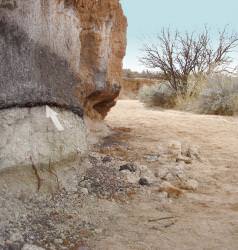Scientists think they might have the solution to a mystery that’s been haunting paleontologists for years: what caused an abrupt period of cooling 13,000 years ago and an extinction of the large mammals. The conventional theory is that when human hunters arrived in North America, they killed off all the tasty large mammals. But there’s evidence that a comet exploded over North America at approximately the same time. This could also cause cooling, and wipe out the animals.
The discovery was made by scientists from the University of California at Santa Barbara. They analyzed more than a dozen archaeological sites across North America, and found they all had high concentrations of iridium. This element is a rare substance on Earth, but known to be in many comets and asteroids. Whenever these objects impact the Earth, they leave a blanket of iridium behind which serves as a marker. As archaeologists dig down through the layers of material, they’re looking back in time, and can accurately date when the object struck.
If this theory is correct, a comet approximately 4 km (2.5 miles) across detonated in the skies above North America, and rained fragments down across the whole region. The extreme temperatures would have ignited wildfires across the continent, destroying the vegetation that the large mammals needed to survive. Their death would then lead to a cascade of deaths by the large predators and the rest of the food chain that relied on them.
The comet might have also destabilized a large portion of the Laurentide ice sheet, causing a high volume of fresh water to flow into the ocean. Climate researchers believe this kind of event can disrupt the normal circulation of the ocean’s flow, and lead to a global cooling event. Ecosystems across the planet would have suffered.
Ancient cultures, such as the Clovis people of North America relied on mammoths and other large mammals for food. They would have been affected by the impact, and this might have caused their culture to die out.
Original Source: NSF News Release


Many of us also believe this is approximately the same time Mankind also came close to extinction. We believe Man’s technology was more advanced than most believe. Very little evidence of this technolgy would be left after all this time. We spent the next 3-4 thousand years “surviving and coming back from the brink. There is a good chance this type of Mass Extinction has happened before then and will probably happen again. We know it takes 7,500 for man to go from Hunter/Gatherer to Solar Explorer, so what happened to man the previous 400,000 years or more that we’ve been around? Oh yeah, we sat around the cave afraid to cross the next ridge, or ocean. Somehow, I don’t think so.
this is correct, the pyramids were here also, can they be checked for penetration of particles
I find this theory very convincing and a more reasonable explanation for the extinction or extirpation off this continent of so many large species than the notion that humankind wiped them out; giant ground sloths, NA cheetahs,dire wolves, short-faced bears, camels, horses?! I don’t see that as a likelihood but I’d like to hear evidence either way-
Our solar system is part of larger orbit in our galaxy, just as the earth completes a cycle every 365 days., our sun and its planets enters the milky way plain every +/-13000 years.
The tremendous magnetic field and gravitational force will greatly interfere with the earths weather causing many natural disasters before we enter the belt. When we finally enter the earth’s rotation slow down to a standstill for 7 days and seven nights, the earth is then showered with asteroids causing extinction. Pole shift will occur as it exits.
The above post(Jacques) is a bit….well….totally wrong….strike that, it is not even wrong….it is funny though 🙂
It is becoming common knowledge that Dec 21, 2012 is the day that the Mayans predicted the end of the world. Scientists all over the world are working on the “polar shift” theory as we speak. Expect the hype and the fear to increase as we get closer to that date, just like Y2K.